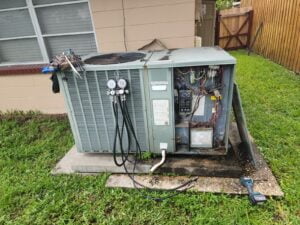AC Refrigerant Selection: 7 Proven Tips for Homeowners
In the realm of home comfort, air conditioning systems play a pivotal role. Central to the efficient functioning of these systems is the choice of AC refrigerant. The selection of the right refrigerant is crucial not only for optimal cooling but also for environmental considerations. This comprehensive guide aims to provide homeowners with seven proven tips for selecting the ideal AC refrigerant. Throughout the journey, we’ll explore the significance of AC refrigerants, their types, environmental impact, and practical steps to ensure a well-informed decision.
Understanding the Significance of AC Refrigerants
AC refrigerants, often referred to simply as refrigerants, are the lifeblood of air conditioning systems. These substances circulate through the system, absorbing heat from indoor air and releasing it outdoors. The choice of refrigerant profoundly influences the cooling efficiency, energy consumption, and environmental footprint of your AC system.
In the pursuit of creating a comfortable and refreshing indoor environment, air conditioning systems have become an essential part of modern living. At the heart of these systems lies the AC refrigerant—a crucial component responsible for cooling the air and providing the soothing breeze we all enjoy during hot summer days. However, not all refrigerants are created equal. In this comprehensive guide, we will delve into the diverse world of AC refrigerants, exploring their types, properties, environmental impact, and their role in keeping our homes cool and comfortable.

The Role of AC Refrigerants
AC refrigerants are the substances that cycle through your air conditioning system, absorbing heat from indoor air and releasing it outside. As they transition between gaseous and liquid states, they facilitate the heat exchange process, allowing your home to remain pleasantly cool even in scorching weather. The choice of AC refrigerant has far-reaching implications for energy efficiency, environmental concerns, and the overall performance of your cooling system.
Types of AC Refrigerants
- R-22 (Freon): The Legacy Refrigerant R-22, commonly known as Freon, was once the industry standard for AC systems. However, its use has declined due to its harmful impact on the ozone layer. Many countries are phasing out R-22 in favor of more eco-friendly options.
- R-410A: The Leading Replacement R-410A has emerged as a prominent replacement for R-22. This hydrofluorocarbon (HFC) refrigerant is ozone-safe and boasts better energy efficiency. Its widespread adoption has contributed to more environmentally conscious cooling systems.
- R-32: The Eco-Friendly Alternative R-32 is gaining attention for its significantly lower global warming potential compared to other refrigerants. It requires less refrigerant volume, leading to reduced environmental impact and energy consumption.
- R-134a and R-407C: Application-Specific Refrigerants While R-134a and R-407C are less common in residential systems, they find use in specific applications. R-134a is often employed in automotive air conditioning, and R-407C serves as an alternative for some systems.

7 Proven Tips for Homeowners
- Assess System Compatibility: Different AC refrigerants operate under varying pressure and temperature conditions. Ensure your chosen refrigerant is compatible with your system’s design to ensure optimal performance and safety.
- Consider Energy Efficiency: Opt for refrigerants that promote energy efficiency. R-410A, for instance, offers not only effective cooling but also energy savings, resulting in reduced utility bills.
- Evaluate Environmental Impact: Prioritize refrigerants with lower global warming potentials. These options contribute to a smaller carbon footprint, supporting your commitment to a greener lifestyle.
- Stay Informed about Regulations: Stay updated on regulations regarding AC refrigerants. Regulations may impact the availability and use of certain refrigerants, influencing your decision-making process.
- Consult Professional: Seeking advice from HVAC professionals is essential. They can analyze your specific needs and recommend the most suitable refrigerant based on your system and preferences.
- Plan for Maintenance: Regular maintenance ensures your AC system operates smoothly with minimal refrigerant leakage. Consider enrolling in maintenance plans that include leak detection and prevention.
- Weigh Long-Term Benefits: When choosing an AC refrigerant, look beyond immediate costs. Consider the long-term benefits in terms of energy savings, environmental impact, and the overall lifespan of your AC system.
Environmental Impact and Regulations
- Global Warming Potential (GWP): The parameter of Global Warming Potential gauges a refrigerant’s potential to induce global warming over a designated timeframe. Opting for refrigerants with lower GWP values is pivotal, given their reduced adverse effects on climate change.
- Montreal Protocol and Phasing Out of R-22: The Montreal Protocol stands as a seminal agreement addressing the depletion of the ozone layer, primarily targeting substances such as R-22. The protocol’s implementation has steered the transition towards more environmentally benign refrigerants like R-410A.
- Kigali Amendment: The Kigali Amendment represents an extension of global efforts to curb the environmental impact of refrigerants, with a specific focus on hydrofluorocarbons (HFCs). As nations progressively adopt refrigerants with lower GWP values, alignment with the Kigali Amendment gains prominence.
Factors to Consider When Choosing Refrigerants
- System Compatibility: The varying pressure and temperature characteristics of different refrigerants necessitate system adjustments. Thus, when considering a refrigerant, ensuring compatibility with the system’s design is paramount to its optimal functionality.
- Energy Efficiency: High-efficiency refrigerants, typified by R-410A and R-32, bear the potential to usher in energy savings and diminished operational expenses. Embracing such refrigerants entails contemplating long-term advantages grounded in reduced energy consumption.
- Environmental Impact: The conscientious selection of refrigerants boasting lower GWP values resonates with sustainability endeavors. By embracing environmentally conscious options, stakeholders contribute to the preservation of the ecosystem and its delicate equilibrium.
- Regulatory Compliance: A cognizant adherence to evolving regulations and phase-out schedules safeguards ecological interests and averts potential legal complexities. Staying well-informed aids in environmental stewardship and fosters a responsible approach toward air conditioning systems.

Installation, Maintenance, and Safety
- Professional Installation: The significance of meticulous installation cannot be overstated. Enlisting the services of seasoned HVAC professionals is paramount to configuring refrigerant charging and system setup in a manner conducive to optimal performance.
- Regular maintenance routine: maintenance emerges as a proactive measure against refrigerant leaks and system wear. Maintenance plans, akin to the Therapy Maintenance Plans introduced by local contractors, extend the peace of mind by ensuring the consistent upkeep of air conditioning systems.
- Safety Precautions: Acknowledging the potentially hazardous nature of refrigerants underscores the importance of their cautious handling. Adherence to established safety protocols by technicians mitigates the risks of leaks and inadvertent exposure.
Shaping Comfort and Sustainability with Informed AC Refrigerant Choices
The selection of the right AC refrigerant transcends mere cooling efficiency—it’s a decision that impacts energy consumption, environmental responsibility, and the overall comfort of your home. With R-410A and R-32 emerging as efficient and eco-friendly options, homeowners are now empowered to make informed choices. By adhering to the seven proven tips outlined in this guide, you’re not only enhancing your living space’s comfort but also contributing to a more sustainable future. Remember, each decision you make today shapes the environment of tomorrow.
The narrative of air conditioning refrigerants unfolds against a backdrop of scientific progress and environmental stewardship. The evolution of refrigerants reflects the aspirations of a greener future—a future wherein comfort harmonizes seamlessly with ecological considerations. Whether it involves embracing the contemporary efficiency of R-410A, embracing the eco-friendliness of R-32, or the conscientious observance of safety measures, each facet forms a mosaic that contributes to a sustainable tomorrow in the domain of residential air conditioning. Through informed choices, steadfast adherence to regulations, and a commitment to the well-being of the planet, stakeholders partake in an inspiring journey towards cooler indoor climates and a warmer planet’s heart.
AC refrigerants are pivotal to the functionality of air conditioning systems, shaping our indoor comfort and environmental impact. As we progress towards more sustainable and eco-friendly solutions, the choice of refrigerant becomes even more critical. By understanding the types of AC refrigerants available and their respective advantages, homeowners can make informed decisions that not only keep their living spaces cool but also contribute to a greener and more comfortable world for generations to come.
The Cooling Cycle
At the core of every air conditioning unit lies a fundamental cooling cycle driven by AC refrigerants. This cycle involves four key components: the evaporator coil, the compressor, the condenser coil, and the expansion valve. AC refrigerants flow through this cycle, transitioning between gaseous and liquid states to facilitate heat exchange.
- Evaporator Coil: AC refrigerant enters the evaporator coil as a low-pressure gas. As warm indoor air blows across the coil’s fins, the refrigerant absorbs heat from the air, causing it to evaporate and transform into a low-temperature gas.
- Compressor: The now-cooled gas refrigerant is drawn into the compressor, typically located outside the home. The compressor compresses the gas, raising its temperature and pressure. This process increases the energy of the refrigerant, making it ready for the next phase.
- Condenser Coil: The high-pressure, high-temperature gas refrigerant then flows into the condenser coil. Here, outdoor air blows across the coil, dissipating the heat absorbed from indoors. As a result, the refrigerant condenses back into a high-pressure liquid.
- Expansion Valve: The high-pressure liquid refrigerant moves through the expansion valve, where it undergoes a sudden drop in pressure. This causes the refrigerant to rapidly expand and cool down, returning it to a low-pressure gas state. The cycle then begins anew.

Importance of AC Refrigerants
The seamless execution of this cooling cycle relies entirely on the properties of AC refrigerants. Here’s why AC refrigerants are of paramount importance:
- Efficient Heat Transfer: AC refrigerants possess remarkable heat-absorbing and heat-releasing abilities. They efficiently transport heat from indoor air to the outdoors, resulting in cooler indoor temperatures.
- Thermodynamic Principles: AC refrigerants follow the principles of thermodynamics to facilitate the heat exchange process. Their ability to transition between gas and liquid states at varying pressures and temperatures enables effective cooling.
- Energy Efficiency: The choice of AC refrigerant significantly influences the energy efficiency of the entire cooling system. Modern refrigerants like R-410A and R-32 are designed to optimize cooling performance while minimizing energy consumption.
- Environmental Impact: AC refrigerants have a direct impact on the environment. Ozone-depleting refrigerants like R-22 have been phased out due to their harmful effects. The transition to eco-friendly refrigerants like R-410A and R-32 aligns with global sustainability goals.
- Comfort and Convenience: Ultimately, AC refrigerants are the reason we can enjoy a comfortable indoor environment, even in the most extreme weather conditions. Their ability to regulate temperature makes our homes havens of relaxation and relief.
As we consider the role of AC refrigerants, it’s clear that their proper selection is critical to achieving efficient and sustainable cooling. Homeowners and HVAC professionals alike must factor in the properties, efficiency, and environmental impact of these refrigerants to ensure a harmonious balance between cooling comfort and responsible resource utilization. In the grand theater of air conditioning, AC refrigerants are the scriptwriters, choreographers, and performers—all working together to create a masterpiece of cooling comfort.
What benefits do eco-friendly AC refrigerants offer in terms of carbon footprint reduction?
In the quest for a more sustainable and environmentally responsible future, the choice of eco-friendly AC refrigerants has emerged as a pivotal factor. As concerns about climate change intensify, homeowners, businesses, and industries are increasingly turning their attention to solutions that minimize their carbon footprint and contribute to a healthier planet. Eco-friendly AC refrigerants, with their reduced global warming potential (GWP) and environmentally conscious attributes, offer a multitude of benefits that extend beyond just efficient cooling.
1. Lower Global Warming Potential (GWP) for Climate Mitigation
One of the primary advantages of eco-friendly AC refrigerants is their lower GWP compared to traditional refrigerants. GWP measures a substance’s potential to trap heat in the atmosphere, contributing to global warming. By opting for refrigerants with lower GWP values, individuals actively participate in mitigating the adverse effects of climate change. These refrigerants release fewer greenhouse gases into the atmosphere, reducing the overall heat-trapping potential and helping to curb the rise in global temperatures.
2. Reduced Greenhouse Gas Emissions
The shift to eco-friendly AC refrigerants directly correlates with a reduction in greenhouse gas emissions. The widespread adoption of these refrigerants translates to a significant decrease in the release of harmful gases that contribute to the greenhouse effect. As a result, the carbon footprint associated with cooling systems is diminished, making a positive impact on the environment and helping to achieve international climate goals.
3. Regulatory Compliance and Environmental Responsibility
Governments and regulatory bodies around the world are enacting measures to limit the use of high-GWP refrigerants and promote the adoption of eco-friendly alternatives. Choosing these refrigerants ensures compliance with evolving regulations and showcases a commitment to environmental responsibility. By aligning with such standards, individuals and businesses contribute to a collective effort to safeguard the planet for future generations.
4. Enhanced Energy Efficiency
Eco-friendly AC refrigerants are often paired with energy-efficient cooling systems. This combination leads to optimized energy consumption, as these refrigerants work seamlessly with technologically advanced equipment to provide effective cooling while consuming less power. The result is not only a reduction in energy bills but also a decrease in the associated carbon emissions, promoting a greener approach to comfort.
5. Long-Term Sustainability and Future-Proofing
As the world transitions towards sustainable practices, the relevance of eco-friendly AC refrigerants becomes more pronounced. Choosing these refrigerants ensures that your cooling system remains aligned with changing regulations and preferences, avoiding the need for costly retrofitting or replacements down the line. This future-proofing of investments underscores the importance of making environmentally conscious decisions.
6. Public Image and Corporate Social Responsibility
In an era where environmental awareness is on the rise, choosing eco-friendly options can enhance the public image of individuals and businesses. Such decisions are indicative of a commitment to corporate social responsibility and a genuine concern for the well-being of the planet. Customers and stakeholders often respond positively to organizations that prioritize sustainability.
7. Preservation of the Ozone Layer
Certain eco-friendly refrigerants have minimal impact on the ozone layer, which plays a crucial role in protecting life on Earth from harmful ultraviolet (UV) radiation. By selecting these refrigerants, individuals contribute to the healing process of the ozone layer, promoting a healthier and safer environment.
8. Inspiration for Collective Change
The act of choosing eco-friendly AC refrigerants extends beyond personal benefits. It sends a clear message to industries, communities, and policymakers that sustainable choices are not only feasible but also essential. By leading by example, individuals and businesses inspire others to consider and adopt environmentally responsible practices.
In conclusion, the benefits of eco-friendly AC refrigerants reverberate through various facets of society and the environment. From mitigating climate change and reducing greenhouse gas emissions to complying with regulations and promoting energy efficiency, these refrigerants offer a holistic approach to responsible cooling. Embracing the transition to eco-friendly AC refrigerants is an investment in a greener future—one where comfort, efficiency, and environmental stewardship harmoniously coexist.
Making Informed Choices with The AC Therapist
As the sun beats down, and the need for a cool, inviting home becomes paramount, the significance of AC refrigerant selection comes to the forefront. In this journey of understanding, we’ve navigated through the nuances of refrigerant types, energy efficiency, and environmental considerations. The AC Therapist has illuminated the path, offering 7 proven tips that empower homeowners to make confident decisions.
The harmony of comfort and eco-consciousness becomes tangible when we choose the right AC refrigerant. Guided by these insights, homeowners can now take charge of their cooling systems, transforming their living spaces into sanctuaries of refreshing relief. The AC Therapist’s expertise paves the way, reminding us that cooling our homes responsibly not only soothes our senses but also nurtures our planet. As you embark on your refrigerant journey, remember that every choice counts—your comfort, your environment, and your legacy.









